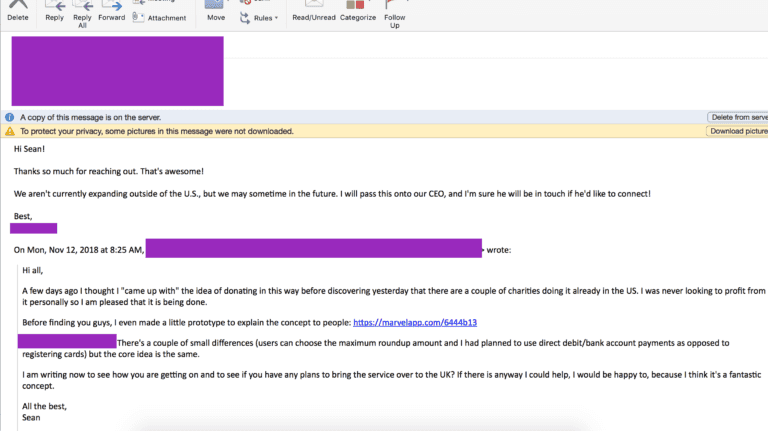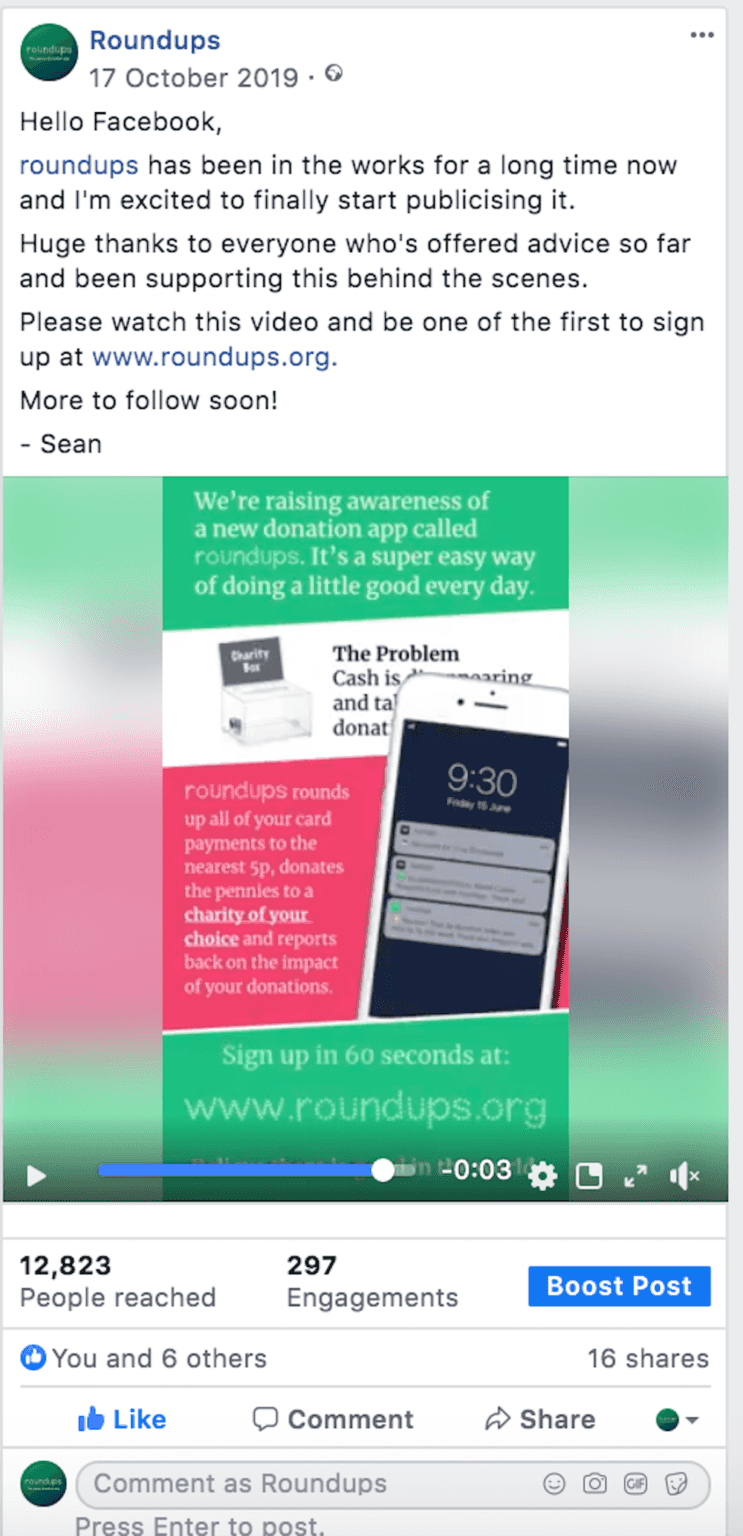The Roundups Story | Part 1

We have decided to document the Roundups startup journey through a series of blog posts. At the time of writing the first one (25/03/2020), it feels a little silly naming this series ‘The Roundups Story’ as if our young startup is a story worth telling. It’s probably not... yet. It is, however, really useful for us to process and present our developments while they are relatively fresh.
If Roundups is the success we hope and believe it will be, then these posts will be a raw account of the ride. If it is not, then these posts will still be a raw account of the ride. I hope that the time capsules we leave here will be useful in any case.
The Spark
The idea for Roundups first came to me one night in November 2018. It was one of those moments where your brain lights up and gushes with ideas that relentlessly fizz around in full colour. I’ve had that sensation several times in my life. It’s exhilarating. Usually, however, you quickly find that someone else already had this idea or that it isn’t feasible for one reason or another. The fizz fizzles out, you’re a bit disappointed and you move on.
I have found that if you do not quickly find a reason that your startup idea doesn’t work, if you don’t find a showstopper, that excitement grows – fast. Your optimism swells and you begin to burn with energy. This is exactly what happened with Roundups. Minutes after it came to me, I Googled around and couldn’t find anything like it. It was one of those ideas that I couldn’t believe didn’t already exist. My excitement and optimism swelled further.
Whatever plans I had for that evening went straight out the window. My next step was to put together a basic mockup so I could easily share the concept with friends. Here are some screenshots of that very first effort. Roundups didn’t have an ‘s’ and the actual mechanism for rounding up was very different (and a lot more confusing). This was put together in a few excited hours after having the idea and not being able to find anything pre-existing. I remember it clearly. It had gotten late and I was still working away on my laptop in bed, in the dark.
It was November 11th to be precise. I know this because that same night I shared the idea via Facebook message with a few friends who work for charities, and I have just checked the date of those messages.
The Extinguisher
The immediate reaction I got from friends was so positive that my excitement bubbled over and I decided to post a short summary of the concept on Facebook in order to request general feedback/critique. A friend from America commented on the post, sharing two or three links to various Roundup-and-Donate services that were already live in The States. My heart sank. Like most good ideas, several other people had previously thought it up. And notjustbefore me, but months if not years before me.. I still don’t know why my initial Googling didn’t uncover these other services, I suspect because they were American and I was in the UK. Nevertheless, I had found them.
It would be fair to say that I was more than a little embarrassed. I had publicly shared my excitement about this amazing “new” idea but it was already out there. Freezing cold water had been thrown over my excitement. It was like a sucker-punch as I lay there in the dark. I’ve just had a look to see if I could find that post on Facebook but I think I hid or deleted it! In my defence, I didn’t hide the post because of the embarrassment but because it seemed pointless to garner feedback on an idea that could be a non-starter. It was better to hide it then, late at night when few people had seen it, than to have the “ah yeah I found out it’s been done before” conversation several times the next day.
The Reignition
After the sinking feeling passed, my rational, thick-skinned self came back. I am a big proponent of the lean startup, failing fast and all of the other startup clichés of this ilk (they’re clichés because they’re true). So, I was happy to have this information so quickly. All I “wasted” was a couple of hours putting together some very basic wireframes on Invision. Next, my attention turned to more useful questions. “This is a great idea” I thought, so:
Why hadn’t I heard of it?
Why isn’t it in the UK?
Do the commercials make it difficult to scale?
I also realised that these other services were significantly different in their Roundup mechanism. My instinctive intention was to digitally replicate throwing the “coppers” back into a charity box upon receiving change. In the screenshot above you’ll see that the plan was to round everything up to 10p. I was literally trying to replace these 1p and 2p donations. Aside from donations being very low with this method, the mechanism itself was confusing. I quickly realised that transactions should always be rounded up to a set figure.
More importantly, these other services all rounded transactions up to the whole £/$1.00. I understood why this was the case. It’s simple to understand and it’s exactly what Monzo, Revolut et al do for their round-up-and-save mechanisms. However, I felt that this approach was very much at odds with trying to replicate loose-change penny donations. Personally, I would always put the copper coins back into the charity box when given change, but I usually kept the silver. With rounding up to £1.00, you are being asked to potentially donate up to 99p every time you use your card. I felt like that was too much to ask from most potential donors. I thought it conflicted with the strength of the whole concept, which is asking (lots of) people to do very little. So, my intention to allow users to Round-Up-And-Donate to lower amounts (5p, 10p, 50p or £1) was a USP, even if not a defensible one.
With my initial excitement tempered, to a sensible level, I decided to reach out to one of the American companies delivering the round-up-and-donate system already. It is important to note at this point that my intentions were (and remain) completely honourable. Inside the 4 or 5 hours that this idea had come to life, I only ever thought of it as a voluntary, charitable endeavour. I had barely considered the commercial model at all. What excited me was the potential social impact this thing could have. This was refreshingly liberating. It gave me the freedom to contact this other provider, a would-be competitor in the normal business world, without any hesitation. I emailed them and told how I had “had” this idea and how I thought it was fantastic. I asked if they were planning on expanding to the UK and effectively volunteered to help. I got an email back to say that someone would get back to me, but they never did. EDIT: I’ve just found the actual email exchange:

Knowing that this new form of fundraising already existed definitely dulled my excitement for it. Aside from being genuinely passionate about doing good in the world, I would be lying if I said that I wasn’t equally excited about being the one to deliver this innovation. The same still applies today. It’s egotistical but it’s the truth.
Anyway, being pragmatic (and following lean principles), I decided it would not be wise to not invest any significant time into this idea just yet. Instead, I would see how the American market developed and if any of the UK FinTechs and/or challenger banks started to do anything in this space. That’s code for “life got in the way and it all got put on the back burner.” Roundups was, however, always there in the back of my mind.
The Fire
On the 25th April 2019 I registered the domain name www.roundups.org. I decided that this donation mechanism was too good to not exist in the UK. I decided that I would begin a gradual transition away from my previous business so that I could explore the idea properly. What followed was a vast amount of desk research and a series of sporadic meetings and calls. During these months I still had to spend the majority of my time on my bill-paying work, so the progress was slower than I would have liked. Nevertheless, I did everything I could to move the Roundups project forward. Broadly speaking, there were three key areas of work: understanding how donors and charities might react to this proposition, figuring out how the thing would work (technically and legally) and finding a techie to actually build it!
I will talk more about finding a technical co-founder in another blog post but the short story is that I found-and-lost one and then failed to find another after months of trying. This did not deter me. Months of part-time work across the three areas above yielded encouraging results; I had cultivated a rough – but legitimate – technical understanding of how this donation platform would work; and I had brought this all together into a basic website. I was launching a tech startup – without a tech person.
On the 17th October 2019 I took a deep breath, swallowed the pangs of anxiety and posted about Roundups for the first time. At least 6 other people thought it was a good idea.
